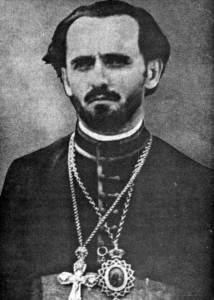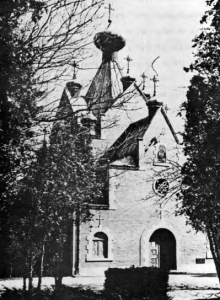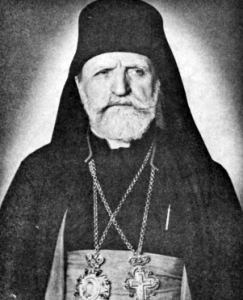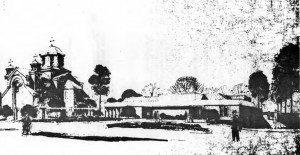Part III: The Serbian Community of Cleveland
The Serbs and Their Religion
Nikolaj Maric
The Early Years to 1950
Serbs are a religious people and the majority are affiliated with the Eastern Orthodox religion. In Cleveland, a few attend services at churches other than Eastern Orthodox –St. Nicholas Byzantine, Yugoslav Seventh Day Adventist, Cleveland Islamic Center, and Apostolic Christian Church. However, about 90% profess allegiance to the Eastern Orthodox religion. The following excerpt from a recent sermon by Father Jovan Todorovich of Gary, Indiana expresses the feelings many Serbs have toward their religion:
“The greatness of a nation is measured by the spiritual power it wields to overcome life’s obstacles. Just as Christ is an eternal well of spiritual refreshment leading to eventual rebirth, so is the tradition of a God-loving nation. Its generations can drink of the same life-giving waters for the spirit to create new works. There are few people on earth whose history brims with as much suffering for its Orthodox Christianity as the Serbian nation. So there are few nations as spiritually great.”
The Serbs accepted Christianity in the eighth and ninth centuries. Since then, the Serbian Eastern Orthodox Church and the Serbian nation have remained inseparable despite attempts by diverse enemies to destroy their religion and their nation. From the time of Tsar Dusan’s Great Serbia of the 14th century to the present Tito regime, Serbian enemies have tried to separate the people from their religion in order to crush their resistance and create docile subjects. In the beginning of the 19th century Serbs again tried to repel the 500-year-old Turkish rule. During this unsuccessful uprising of Bosnian Serbs against the Turks, deacon Avakum was taken prisoner by the Turks in Belgrade, where his mother was also imprisoned. Deacon Avakum was offered a choice: either renounce his Serbian Orthodoxy or die at the stake. Avakum’s mother tried desperately to talk her son into becoming a Moslem in order to save his life, but he would have no part of it. He said to his tormentors, “You can do anything with me that you want… You can do anything with my body that your beastly temper wants. But you can not master my soul… The Serb will never give up his soul to live…” Avakum was subsequently killed and later proclaimed a Saint of the Eastern Orthodox Church.


Throughout Serbian history Serbs have been put to similar tests by various tormentors. In World War II Croatian quisling Pavelich tried either to Catholicize or to exterminate Serbs who, on Hitler’s orders, had been expedited to Croatia. A Croatian priest, Mate Mugosa, in his speech of June 13, 1941, threatened:
Till now we have worked for the Catholic faith using prayer book and cross, and now is the time to use the rifle and revolver. We shall evict and exterminate the Serbian people in Croatia, and I shall be happy to be able to distribute the Serbian land to Croatians. Ustashe will mercilessly fight and exterminate all those who are not loyal to NOH (so-called independent state of Croatia) and to her poglavnik (leader) and creator, Ante Pavelich. Take a look, people, at those 16 brave Ustashes who have 16,000 bullets which will kill 16,000 Serbs, after which we shall distribute the Mutilicko and Krbavsko plains … (Text is from the Memorial Museum of Jasenovac, Yugoslavia.)
The Communist takeover of Yugoslavia after World War II discouraged Serbian Orthodoxy and other religions as well. Today the Serbian church continues its struggle for survival against an oppressive and atheistic government.
In America Serbs can worship freely as they did when Serbia was a free state. When Serbia was independent, Church and State were not separated. Wealthy benefactors built churches and monasteries and supported the clergy. Religion flourished. Serbian immigrants to America had freedom to worship but not wealth, and they were obliged to build their own churches. While Serbs, as a rule, seldom attend services daily or even weekly, they crowd the church on holidays such as St. Sava’s Feast, Christmas and faster. Also, each Serbian household displays an icon of its patron saint to whom private prayer and devotion are encouraged. However, public ritual and an official place of worship are essential to Serbian religious orientation. Consequently, the first order of business of the early Serbs who formed the St. Sava Benevolent Society of Cleveland was to buy or build a church.
St. Sava Serbian Orthodox Church of Cleveland began quite simply in 1909 when services were held in a rented hall on St. Clair Avenue at East 41st Street. This small church-school congregation soon’ dissolved for lack of funds but resumed again in 1911. Within a short time, they purchased two small frame houses on East 33rd Street near St. Clair Avenue. One was used as a church, the other as a priest’s residence. This $2,600 investment soon became a center around which Serbs built the kind of life they had known in Europe. The tudjina (foreign land) was now more bearable.

The children of St. Sava’s were soon being instructed in the Serbian language and given the rudiments of the Eastern Orthodox religion and Serbian history and culture. Their first teachers were Mane Momcilovic and Father Nikodim Stojakovic. Cleveland resident, Mimi Naperta recalls, “We were busy in those days. We would come home from regular school and then hurry off to Serbian school which was held twice a week from four to six in the afternoon. And if that were not enough, there were choir rehearsals three times a week, too.”
The new congregation was hardly established when they were called upon to assist Serbia in its struggle to gain independence from the Ottoman Empire in 1912. Serbian organizations joined with St. Sava’s in collecting money and goods to send to Serbia. Many Cleveland Serbs enlisted with Serbian Armed Forces to fight the Turks.
Before long, a new church building became imperative as the Serbian community grew and the small frame house bulged with worshippers. It was learned that the German Lutheran Church at East 36th Street was for sale, and in 1919 this was purchased and became the new St. Sava Church. Many Serbs who for years had lived in rented homes, bought houses on streets near the church. The neighborhood was becoming predominantly Serbian.
The Serbs got along well with other nationalities with the possible exception of the Croatians. Bitter experiences with the Croats in Europe during World Wars I and II cast a pall over their relationships with them in this country and made cooperation with them difficult.
Following World War II, when it had become obvious that the Communists would control Yugoslavia, thousands of Serbs left the country and many hundreds of them settled in Cleveland, finding employment and housing in the vicinity of St. Sava’s Church on East 36th Street. Thousands of Serbs who survived the German prisoner of war camps were confronted with problems: to go home to live under Communist regime or to become D.P. IS (displaced persons). Many thousands went to England, New Zealand, Australia, Africa, Canada, U.S.A…. One of these immigrants, Ratko Simic, recalls his experience:
We arrived in New York in 1950 and each received $5.00 from the fund allocated to us by the American government. We came to Cleveland shortly after and stayed at Crawford Hotel on Prospect Avenue, where we had to pay $21.00 a week each for room and board; there were seven of us in one room, and only two beds and one chair in the entire room… About 100 Serbs were immediately employed by the Ferro Company of Cleveland.
Many of these newest immigrants were helped to reach America through the combined efforts of the Serbian Orthodox Diocese of American and Canada, the Serbian National Defense Council of America, and the International Refugee Organization. Cleveland Serbs welcomed their fellow countrymen, pleased at the strength and numbers they added to the community. They, in turn, having escaped an oppressive and atheistic government, relished the opportunity to enjoy political and religious freedom once again.

1950 to the Present
The influx of immigrants in the 1950’s infused new life into the Serbian community. Young and vigorous, the newcomers joined St. Sava Church and eagerly participated in religious, social and political organizations. Particularly helpful in facilitating their adjustment to Cleveland were oldtimers, Ilija Zegarac, Bogdan Dragisic, Pajo Novakovic and others. When they were not at regular work, they were busy finding the newcomers jobs and housing, and activities to meet their social needs.
St. Sava’s prospered socially and financially through the contributions of these new young immigrants. Very Reverand Father Branko Kusonjic, appointed pastor in 1951, was grateful for their help. The church debt was paid off, Serbian Sunday school was held regularly and in 1952, 30 acres were purchased in Broadview Heights for recreation purposes through the special efforts of Gliso Lonchar, president.
However, with the ever increasing membership, the church at 36th Street was no longer adequate for services and members decided to build a new church. The elected head of the congregation, Trisha-Tom Simic, made a down payment on the chosen site at the corner of Ridgewood Drive and Broadview Road in Parma. On January 15, 1961 the land was consecrated.
As building plans became a reality, far more money than the projected $600,000 would be required to complete the church, school, priest’s residence and parking lot. The congregation sorely felt the increased financial burden and some members differed sharply with the church board as to how to meet these needs. The board passed a resolution whereby each member was to pay $500 to the building fund in addition to regular monthly dues, stipulating that if a member did 163 not pay, his membership rights would be forfeited. This action initiated much bitterness. in the community.
Despite this turbulence, the church services were held for the first time in February of 1963. Unfortunately, before it was consecrated, more problems developed. They began with a letter sent by Patriarch German of the Holy Synod of Belgrade, Yugoslavia to all congregations in America and Canada informing them that, as of May 10, 1963, the American-Canadian Diocese would have to be split into an Eastern American-Canadian Diocese, Middle-Western American Diocese, and Western American Diocese. Bishop Dionisije was temporarily suspended from his duties, and three new bishops were to take over the newly created dioceses: Very Reverend Stevan Lastavica, Archimandrite Firmi1ijan Ocoko1jic, and Archimandrite Grigorije Udicki, respectively.
This was the beginning of a long and costly struggle within the Serbian Orthodox Church in America and Canada, as the Serbs now started taking sides; one group sided with Patriarch German, the other with Bishop Dionisije, head of the American-Canadian Diocese.
St. Sava Serbian Church in Parma was to be consecrated, and the already feuding sides could not agree who should do the consecrating the newly appointed bishops or Biship Dionisije. The stormy meeting took place on June 1, and June 9 was set aside for the consecration. When the day came, the pro-Patriarch German candidates for bishops performed the consecration, and the pastor, Father Kusonjic, refused to participate, thereby expressing his protest at the choice. The somewhat subdued celebration proceeded without further difficulty. However, shortly thereafter, on June 19, 1963 the representatives of nine Serbian organizations issued a joint declaration denouncing the decision of the Holy Synod in Belgrade, thus siding themselves with Bishop Dionisije. They stated that the Holy Synod was forced to the action it had taken by the Commission for Religious Affairs, a government agency of Communist Yugoslavia.
The group siding with Bishop Dionisije was known as the pro American-Canadian Diocese group. The opposing faction, the pro Mother-Church group, under Patriarch German contended that the Holy Synod of Bishops in Belgrade had the right to appoint or suspend clergy as they saw fit. The pro American-Canadian Diocese group argued that since the Orthodox Church in Yugoslavia was not free, it could not function normally.
Possibly, the Patriarchate in Belgrade miscalculated the spirit of Orthodox Serbs outside of Yugoslavia; or, it was coerCed by the Communist Commission for Religious Affairs to act as it did. Whatever the reason for suspending and later defrocking Bishop Dionisije, it created a split among Orthodox Serbs throughout the world, halted the progress of Cleveland’s Serbs, and caused bitter animosity between friends and within families.
Each faction had its own governing board and priest; the Very Reverend Branko Kusonjic was with the pro American-Canadian Diocese group and the Very Reverend Branko Ska1jac with the pro Mother-Church group. Services were held separately. Both groups claimed the right to St. Sava’s Church property and this became a matter which had to be settled in the courts.
The pro Mother-Church group contended that the church property belonged to them because they had remained with Mother Church and their priest was appointed by the new bishops in America and Canada, thus following canonical procedure, a major weapon against the opposition. The pro American-Canadian Diocese group held that the Church in Yugoslavia was not free and had no right to ignore the constitution of the American-Canadian Diocese and the by-laws of St. Sava’s Church in Cleveland.
After 12 years of litigation, on March 23, 1975, a settlement was reached on the allocation of St. Sava Church property. The pro Mother-Church group received the existing buildings in Parma including the church building with one half of the lot. The pro American-Canadian Diocese group received one half of Ridgewood Drive lot, the picnic ground on Wal1ings Road and $215,000. The group moved to Broadview Heights and started to build a church, hall, and school on the St. Sava picnic grounds at 2151 West Wallings Road.

Pastors of the Cleveland Serbian Community
Religious needs of the first Serbian settlers were fulfilled by pastors of existing Eastern Orthodox Churches, such as Greek and Russian, and, in particular, St. Theodosius Russian Orthodox Cathedral.
FR. JASON KAPPANDZE from St. Theodosius was serving the new Serbian community before it had its own church life organized.
Chronologically, the following is a list of pastors serving the St. Sava Serbian Orthodox Church in Cleveland, Ohio.
| 1909-1911 | REV. FR. JOAKIM BJEDOV was a visiting pastor from Mingo Jct. (Steubenville, Ohio), the oldest Serbian Orthodox Community in Ohio. Services were first held in St. Sava Lodge house on Hamilton Avenue and later in a formerly renovated saloon building on St. Clair Avenue between East 40th and East 41st Street. The first president of the congregation was Gajo Germanovic. |
| 1911-1912 | REV. FR. NESTOR VUKICEVIC |
| 1913 | REV. FR. MILAN JUGOVIC |
| 1913-1916 | REV. FR. JOAKIM BJEDOV |
| 1916-1918 | REV. FR. NIKODIM STOJAKOVIC - during his time a German Protestant church building was purchased on East 36th Street with the special efforts of president, Geeo Kukich and Dane Zegarac. |
| 1919-1921 | REV. FR. ALEKSIJE SAVIC |
| 1921-1922 | REV. FR. NIKODIM STOJAKOVIC, second time. |
| 1922-1924 | REV. FR. MARKO KOMNENIC |
| 1924 | REV. FR. PAVLE VELJKOV |
| 1924-1925 | REV. FR. HARALAMPIJE DONOVIC |
| 1925-1928 | REV. FR. DJORDJE PETROVIC |
| 1928-1930 | REV. FR. NIKODIM STOJAKOVIC, third time. |
| 1930-1938 | REV. FR. BORA PETROVIC |
| 1939-1943 | REV. FR. EMILIJAN GLOCAR |
| 1943-1944 | REV. FR. NIKODIM STOJAKOVIC, fourth time |
| 1944-1946 | REV. FR. DANILO KOZOMARA |
| 1946-1950 | REV. FR. MLADEN TRBULOVICH |
| 1950-1951 | REV. FR. BORIVOJE PAVLOVIC |
| 1951-1964 | REV. FR. BRANKO KUSONJIC |
| St. Sava Serbian Orthodox Cathedral | St. Sava Serbian Eastern Orthodox Church |
|---|---|
| 1964-1976 REV. FR. BRANKO SKALJAC | 1964-1974 REV. FR. BRANKO KUSONJIC |
| 1977 REV. FR. MILORAD DOBROTA | 1975 REV. FR. DJURO MAJERLE |
